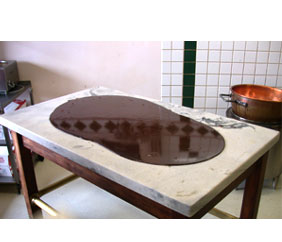
|
At the Fudge House, we were told, the first batch of the day seems to take forever to get firm, but once a few batches of fudge have warmed up the marble slab, the fudge begins to set faster. It seemed pretty strange to us that fudge would set faster on a warm slab of marble than on a cold one. After all, as the fudge cools, sugar molecules start coming out of solution and forming solid crystals. Since crystallization is what turns fudge from liquid to solid, shouldn’t more rapid cooling lead to more rapid solidification?
To
solve this mystery, we talked to Dr. ZoeAnn Holmes, professor of
nutrition and food management at Oregon State University. She confirmed
the phenomenon and explained that when fudge cools slowly on a warm
slab, more crystals have a chance to form. With a higher number
of microcrystals, the sugar has more sites on which to crystallize,
and so crystallization ultimately happens faster.
In
comparison, fudge cooled quickly on a cold slab has less time to
form the tiny
seed crystals
that will grow as the fudge cools.
With fewer crystals to work with, the sugar in solution actually
takes longer to solidify.
|
 The
Marble Slab Paradox
The
Marble Slab Paradox